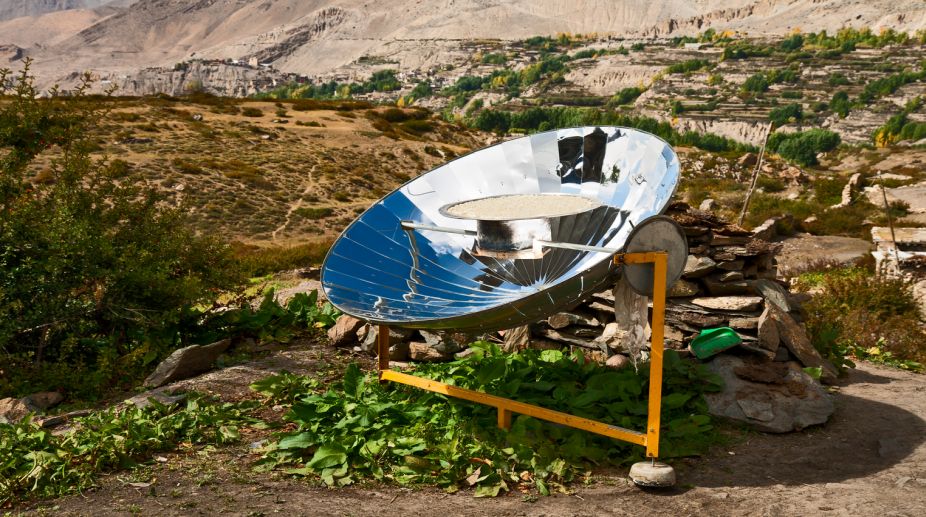Nestled in the foothills of the Aravallis in Rajasthan is a solar power plant which not only caters to the power needs of a township of 10,000 people but also generates power enough to cook over 35,000 meals a day.
With a total capacity of one Mega Watt, 'India One' is the biggest project which works on 'Concentrated Solar Thermal Power technology', say officials at the plant.
Advertisement
Officials at the Ministry of New and Renewable Energy (MNRE) say the plant is the biggest of its type — Solar Thermal.
The project recently earned praise by Prime Minister Narendra Modi, who hailed it as an "inspirational model" in the field of clean energy.
Spread over an area of 25 acre are 770 parabolic reflective dishes, each one with an area of 60 sq meters, which roughly equals to an average 2 BHK house, and produces an output of 1 MW generated purely from water and steam.
"The project works on concentrated solar thermal power technology which is cost-effective and has a high output.It has a relatively simple construction, modular design and an innovative thermal storage concept which provides power round-the-clock," says Yogendra Hingane, who has been associated with the project as engineer and planning expert for over last six years.
India One is a research project of World Renewal Spiritual Trust (WRST), a registered charitable trust/solar research centre and a sister organisation of the NGO Brahma Kumaris.
The project is sponsored by the Ministry of New and Renewable Energy Sources (MNRE) in collaboration with the German government.
India One team consists of about 50 engineers and project support staff which include Golo Pilz, Head of Project, a German settled at Abu Road, and Jayasimha Rathod, the CEO.
While small-scale projects to harness solar energy had started at the Brahma Kumaris centre in Mount Abu and later at its Abu Road based headquarters in the early 1990s, the current project picked pace in 2010.
"The groundwork for India One began in 2006.In 2009 we had applied for permission from the government and work started in 2010. Initially, we experimented with generating power to make tea or heat water.
"Today we are capable enough to provide energy enough to cook more than 35,000 meals a day besides other power requirements here for thousands of people," says Hingane, who has previously worked for international companies in Russia, Dubai, Saudi Arabia and Chile.
Around Rs 80 crore have been so far been invested in the project, he informs that 70 per cent of the cost has been funded by the government and the German collaboration.
"But, 90 per cent of the components used in the project are made in India. Except for the turbine generator, which is not made in India and has been imported from Germany, and the special reflector glass, from the US, everything is indigenous," he says.
He also highlighted how Solar Thermal Power Technology (STPT) was better suited for long-term power need as against the more prevalent photovoltaic cells.
"In PV cells one may want to store the energy and use batteries for that.The batteries these days are made of LED and however carefully maintained, it would need replacement after 4-5 years.These batteries pose threat to the environment and also increase the cost of power generation," explains Hingane.
He added that STPT uses only water to produce steam which was used to create energy and hence, poses no threat to the environment.
According to MNRE's 2016-17 annual report, India's total installed capacity has reached 310 GW with mix of Thermal (69.4 per cent), Hydro (13.9 per cent), Renewable (14.8 per cent) and Nuclear (1.9 per cent).
"It is evident that renewable power has secured the second position after thermal and is spreading its wings rapidly in India," it notes.
Projects on renewable energy assume significance because the government has upscaled the target of renewable power capacity to 175 GW which includes 100 GW from Solar power to be achieved by 2022, the MNRE report says.
India has an estimated renewable energy potential of about 900 GW from commercially exploitable sources including 750 GW solar power, assuming three per cent wasteland is made available, official data says.
While there are several renewable energy projects, some operational and many underway, which have a capacity running into several mega watts, the India-One solar plant is unique because it does not depend on the use of photovoltaic cells, explains an official at the project site.











